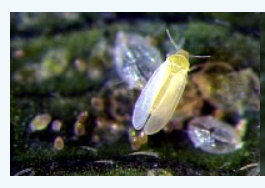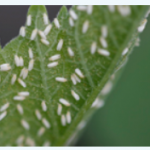By Sarah Bostick and Carol Wyatt-Evens
Gardening in Florida can be incredibly rewarding and incredibly frustrating, at the same time. If you are new to the region, you soon learn that gardening in the Sunshine State can quickly become a full-time job. While our subtropical climate is perfect for growing an abundance of different vegetables, fruits, and herbs, it also can present some overwhelming challenges.
We can help! UF/IFAS Extension Sarasota County agents and staff have created an online edible gardening resource center. The website features short videos from our 25-episode “Edible Gardening Series” webinars, along with blog posts and resources lists for episodes. Get help on an array of topics that befuddle many gardeners.
This week’s Question of the Week is:
What do I need to know silverleaf whiteflies?
The silverleaf whitefly is a tiny insect that causes big problems in the garden and landscape. Whiteflies are small, soft-bodied insects in the order Homoptera. They are related to aphids, mealybugs, leafhoppers, and scales.

There are over 75 species of whitefly in Florida, but Bemisia tabaci, the Silverleaf whitefly, also called Sweet Potato whitefly, is one of the most damaging species on farms and in gardens. It is a major pest of tomatoes, peppers, squash, cucumber, beans, eggplant, watermelon, and cabbage. They are also a major pest of poinsettia, hibiscus, chrysanthemum, ivy, gerbera daisy, lantana, verbena, salvia, and mandevilla. They are known to feed on over 900 host plant species in over 74 plant families and vector over 100 plant-damaging viruses!
Adult whiteflies have a yellow body with white wings and are less then 1mm long. The adults hold their wings in a tent-like fashion over their backs – which is one way you can tell the difference between the Silverleaf and another important species, the Greenhouse Whitefly, which hold their wings flat over their backs.
Whitefly are found year-round in Florida with highest activity in spring through fall. In perfect conditions, there can be up to 21 generations of silverleaf whitefly per year in southwest Florida. The female can lay up to 300 eggs during their 2-week lifespan. The eggs hatch in about seven days when temperatures are between 65-75°F.
What does this mean if you are a home gardener?
A very small infestation of whitefly can very quickly become a HUGE infestation of whitefly.

Here’s why that matters:
Silverleaf whitefly causes direct, physical damage to plants in the process of feeding and indirect damage to plants in the form of viruses and fruit-ripening disorders.
Some common signs of physical damage caused by whitefly are plants with a distorted shape, discoloration, silvering of leaves. stem blanching (turning white), yellow spots, leaf yellowing, and leaf shedding. Symptoms can become so severe that leaves turn yellow, appear dry, and fall off the plant.

These are all symptoms that could have other causes, so the best way to make sure your plant issue is caused by silverleaf whitefly is to tap the plant branch. If a white cloud forms and then disappears back onto the underside of the leaves – you have whitefly.
If you are a vegetable gardener, the indirect damage caused by silverleaf whitefly is your biggest concern. A few of the viruses these tiny insects pass from plant to plant in the process of feeding include: Tomato yellow leaf curl virus (TYLCV), Tomato mottle virus (TMoV), Bean golden mosaic virus (BGMV), Squash vein yellowing virus, Cucurbit leaf crumple virus, and Cucurbit yellow stunting disorder virus. Damage by immature whitefly can also cause a disorder in tomatoes called “irregular fruit ripening”.
So what’s a gardener to do?
If you have plants in your vegetable garden that are showing signs of one of the viruses spread by whitefly, the best thing you can do is dispose of the infected plants. Unfortunately, once a plant is infected, there is no cure. Place a plastic bag over the whitefly infested plant and tie the bag tightly to the base of the plant. Cut the plant off at the base. This process traps the whiteflies living on your infested plants in the bag, preventing them from further spreading the disease. This method is more effective than spraying infested plants with insecticides because silverleaf whitefly has become very resistant to most insecticides.
If you would like to read more about how silverleaf whitefly affects tomatoes, visit this blog post in our Edible Gardening Question of the Week series.
The Edible Gardening Series and blog series is a partnership between the following UF/IFAS agents and Sarasota County staff:
- Sarah Bostick, Sustainable Agriculture Agent
- Carol Wyatt-Evens, Chemicals in the Environment Agent
- Mindy Hanak, Community & School Gardens Educator
- Kevin O’Horan, Communications Associate
 1
1
